Exploring Joshua Tree National Park photography opportunities and all the wonderful available photographic experiences it presents – from cactus, Joshua trees, desert landscapes, desert rock formations and much more.
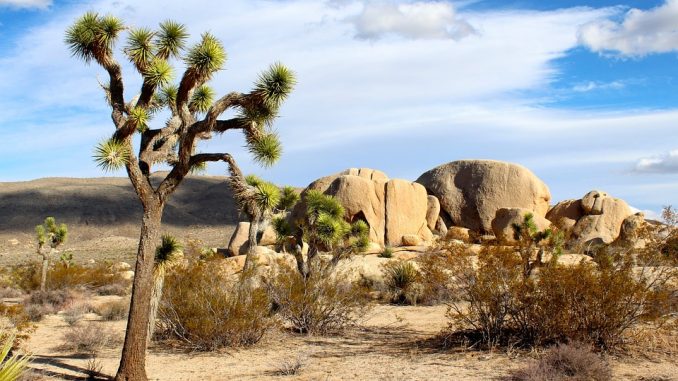
Joshua Tree National Park might be the weirdest place I’ve ever seen, almost like something like a stage set out of a Star Wars movie: “… And may The Force be with you.”
To me, born and raised on the northeastern coast of North America, the Southwest has always looked like the back side of the moon. Instead of green forests, blue lakes, and the limitless Atlantic Ocean, the scenery is mostly bare rock and sand in all its variations, lava fields, great rents in Mother Earth, and dry deserts where my eye is always on my water bottle. Dry, but beautiful.
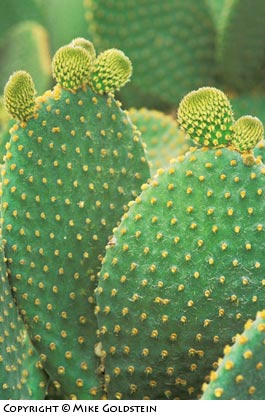
Who wouldn’t gasp at the sight of morning light bouncing off the hoodoos of Bryce Canyon? Who wouldn’t be humbled by the immensity of the Grand Canyon? Who wouldn’t marvel at the effect of late-day sunshine on the Mittens in Monument Valley? Utah, Arizona, and New Mexico have sent me home with pads full of sketches, dozens of rolls of exposed film, and wonderful memories.
Joshua Tree National Park is not beautiful in the usual sense, but it can be said to be rendered beautiful by the very nature of its strangeness. Yet even its namesake is a misnomer.
The so-called Joshua tree (Yucca brevifolia) was named by the Mormons in the 1850’s, as they traveled through the Mojave Desert.
The multitude of spreading branches recalled stories of the outstretched arms of the prophet Joshua, beckoning them onwards to the Promised Land. The Joshua tree, however, is neither tree nor cactus, but a member of the lily family. Its presence above altitudes of 2000 – 3000 feet in southern California marks the borders of the Mojave Desert.
The park and its surrounding desert areas make up the largest U.S. protected wilderness area outside of Alaska. A park this large enjoys a long list of attractions.
The north side of the park, at a higher elevation, has entire forests of Joshua Trees in all their unpredictable shapes and sizes–some of them forty feet high, with a crown circumference exceeding thirty feet, and perhaps as old as a millennium. They began about when the Chinese city of Shanghai was founded, and Leif Ericsson landed on the coast of North America.
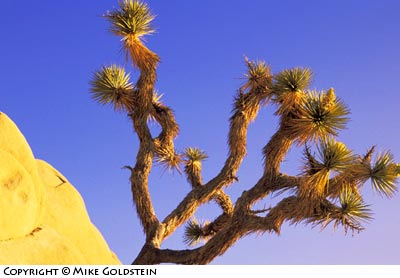
Joshua Tree National Park Photography Tips
After a while, Joshua Trees all look the same, and it is difficult to not keep making the same image. The trick is not to photograph the tree as a tree, but to make the tree only one element of an interesting composition.
Here, I’ve found a study in diagonals. There is not one line that is parallel to the frame of the image (something my artist bride keeps insisting I avoid!). The large amount of sky is a negative space demanding to be filled, and the tree does that job nicely.
In addition, nothing in the composition “ends” nicely – I’ve deliberately clipped off the branches and the trunk of the tree, and the “start” and “end” of the line of rock.
A blue – yellow polarizing filter was used to warm up the afternoon light, and pick up the colors of the tree.
A real desert oasis, the Oasis of Mara, can be found just outside the town of Twentynine Palms. Complete with desert fan palms and a large spring, the oasis looks like it has been transplanted from the depths of the Sahara. However, like all southwestern parks, Joshua Tree’s main attractions center largely on rocks.
Here, the wonderful formations of monzogranite resemble scenes found in southern Utah. The park can even claim its own Arch Rock, a single arch that defies all who would find it. In fact, the many formations represent an irresistible challenge of another sort, a Mecca for rock climbers of all skill levels. The higher hills, that resemble piles of rubble, are Pinto Gneiss; there’s even a large hill of basalt, a relic of a geological upheaval.
In the lower elevation of the Pinto Basin, you can find acres and acres of cholla cactus, the well-known “Teddy bear cactus” (Opuntia bigelovii ). When backlit by the westering sun, these cacti appear fuzzy and cute–but don’t try to hug them! They offer endless possibilities for photographic compositions, from wide-angle scenics to spring-time macros.
For those who enjoy hiking, the park offers a variety of short trails and longer ones, some up to sixteen miles long for a round trip. Old mines, abandoned ranches, and a wealth of geological attractions form destinations for these walks. A number of short nature trails display and explain many of the natural features of the park, as well.
Several large campgrounds have been established in the more interesting and attractive areas of Joshua Tree, providing the usual amenities for car campers. Those at Jumbo Rocks and White Tank will have you sleeping right under many of the great rock formations you might wish to photograph (or climb!) in the early morning light.
Joshua Tree National Park plays host to a wide variety of wildlife, the most commonly seen of which might be the coyote and the greater roadrunner. Lucky (or diligent) observers might also find bighorn sheep, rattlesnakes, or a western grey fox. The cactus wren is a common sight.
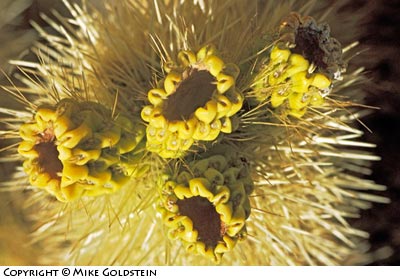
Visitors from the East might find their first-ever cactus blossoms, if they arrive in mid-April–depending on the recent water history and spring temperatures. Those who like to drive, walk, and gawk will enjoy the fifty miles of well-paved roads that will leave even a family sedan undaunted.
There are a host of other back roads, many of them challenging, for those with the clearance, multi-wheel drive, and an urge to “see it all”. The nearest city to Joshua Tree (an easy hour’s drive away) is Palm Springs, a delightful desert oasis of civilization in its own right and not just another airport gateway to a park experience.
The photographic experience in Joshua Tree is somewhat different from that in most parks. While there are broad vistas to be photographed, they are not all that visually exciting, even in “magic hour” lighting. Low-angle light doesn’t seem to “make the world glow” here, as it does in other locations.
The solution to the first problem is to concentrate on small compositions, rather than on the big picture–rock formations, compositions of individual Joshua Trees, cactus, and so forth. In spring, you’ll discover a host of subject material for macro photography while the desert wildflowers and cactus are in bloom.
To counter the lighting problem, a blue-yellow polarizer can produce a wonderful glow on granite rock, giving the impression of late-day light. (In The Story behind the Scenery publication on Joshua Tree, you’ll find this technique has been used extensively.)
As in any desert park, you’ll want to come to Joshua Tree armed with extra camera batteries and suntan oil, an appreciation for a different kind of beauty, and lots of drinking water. Internet exploration can begin at http://www.nps.gov/jotr. You’ll find a wealth of information on the Web about the Park, much of it available for downloading and printing.
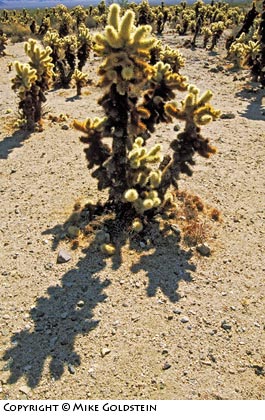
The neatest way to photograph the “teddy bear cactus” (Opuntia bigelovii ) is to do it when the sun is low, so as to backlight this fuzzy cholla, and use its shadow in your composition.
Incidentally, this image was originally photographed with a skyline, and some bright sky at the top of the frame. However, like images made of the Grand Canyon and similar situations, this photo looks best when the sky is cropped out. “Cropping in the camera” is an art form, one I am still learning, after decades of photography!
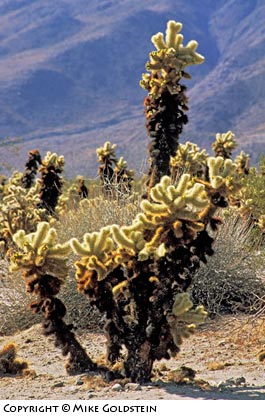
To accomplish this with shots of the cholla cactus in Pinto Basin was easy, as they are tall enough that the “worm’s eye view” is hardly necessary. The distant hill makes a nicely muted and defocussed background.
This image was made in the “Cholla Cactus Garden” section of Joshua Tree National Park, and while I was photographing, Allison checked out the hiking trail in the same area, reporting subsequently that “ … it all looks the same!”
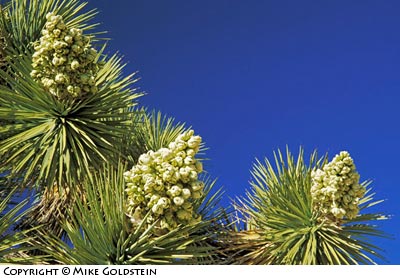
The literature tells us that Joshua Trees only blossom when sufficient rain has fallen in the months prior to spring, and this spring was a very dry one. In fact, we only found one tree that had impressive blossoms, in our wanderings through the Park.
As it happens, this tree was located quite close to a large sanitary facility in one of the campgrounds, and was downwind from it. As I made a number of photographs of these blossoms, I began to notice that the air here did not have the pristine quality that we associated with the rest of the Park.
It was necessary to wait patiently for the breeze to drop before making my photographs, and I had ample time to ponder the effects of airborne fertilization on this particular tree, and the associated plumbing problems that caused it …
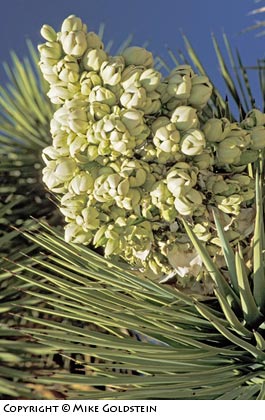
This image of a Joshua Tree blossom was made with my 85-300mm telephoto lens, the blossom being about five feet over my head. These are huge blossoms, some of them a dozen inches tall and equally large in circumference, and one does not need macro equipment to make photographs of them.
I wanted the sky to contrast well with the pale blossom, and so used a polarizing filter on the lens to darken the sky.
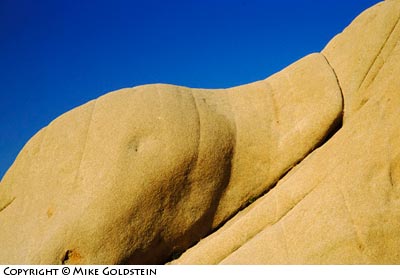
The monzogranite rock formations in Joshua Tree provide wonderful sculpted shapes that draw the eye, and demand attention from the camera – so much so that we were impressed by this feature of Joshua Tree as much as the “trees” themselves!
We explored each of the regions in which these formations are found, but kept returning to the “Jumbo Rocks” area in particular, finding it the most attractive.
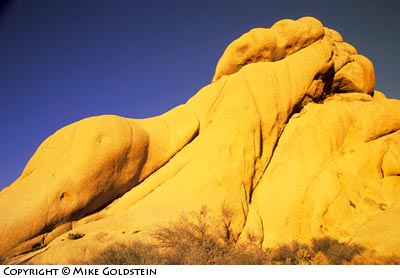
Twisted, poured, flowing, weathered, and extruded, the granite rocks of Joshua Tree National Park supply endless opportunities for photographic abstracts. A 24mm lens with a blue/yellow polarizer framed this pile nicely, and added some color to the late-day lighting.
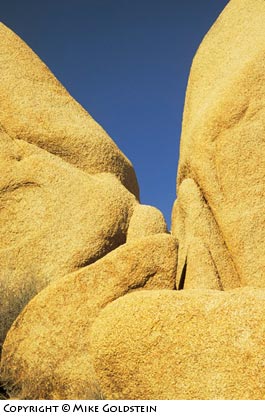
Rock formations throughout the southwest are a joy for the photographer, the challenge being to find interesting compositions, and to simplify them. Geologists can probably explain each line and feature of these rocks, but it was the simple shapes and line constructions that caught my attention. Having an artist wife along, to help isolate good constructions with her magic compositional eye, helped a great deal!
To retain the detail of the rock’s graininess, it is mandatory to use a tripod, and a shutter release cable, for this kind of photography
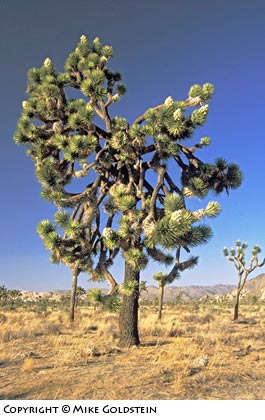
Let’s face it. Those Joshua Trees do have a certain grandeur, and deserve a portrait or two. This particular example was one of the fullest we were able to find,
and I liked the repetition of shapes presented by the others in the background.
A low aspect ensured the tree would fill the background sky, emphasizing its height, and a polarizing filter nicely darkened the sky behind it.
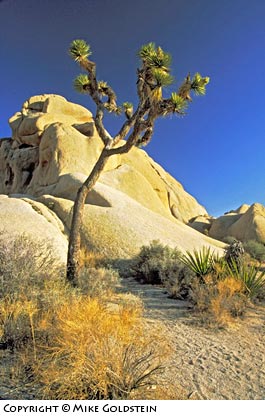
Joshua Tree National Park presented me with only one disappointment, and that was the light. Despite diligence in photographing at the Park mostly in periods of low-angle lighting (early morning, very late afternoon), the light never seemed to provide that fluorescent quality that had so much impact in southern Utah, and Arizona.
When I viewed photos in the Park publication “Joshua Tree – The Story Behind the Scenery” (a wonderful reference that supplied some of the information for this article), I marvelled at the wonderfully warm light that the images display. Why didn’t I benefit from this?
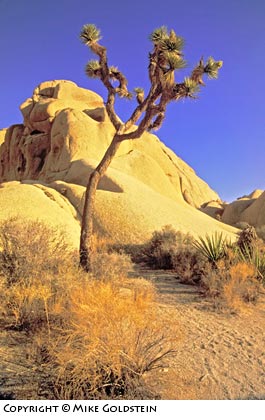
Closer inspection reveals that the warm light (something I very much enjoy in my images) came not from the sun, but from the use of a blue-yellow polarizer, which I’d already discovered has a ‘glowing’ effect on coloured rock and pale adobe. It’s the colour of the skies in these images that gives the secret away.
Fair enough. I never go far without mine, and out it came for the duration of our trip to Joshua Tree.
These two images reflect the difference that the filter makes in your photographs. Which effect you prefer is strictly a matter of taste, and it’s easy enough to make one image with, and another without the filter. My observation is that my artist wife prefers those made “without”, but the ones made “with” are more likely to be published!
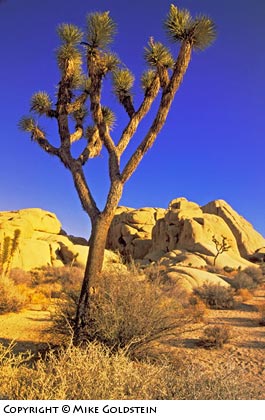
I enjoyed the opportunity for a “major – minor” type of composition here, with the foreground Joshua Tree rearing against the sky, and the horizon, and the very similar tree almost a line drawing against the coloured granite rocks. The late afternoon sun was throwing nice shadows, and beautifully side-lighting the foreground tree.
Incidentally, I found that using matrix-metering and aperture-priority autoexposure with my Nikon F100 worked very well during our days at Joshua Tree National Park. From time to time I would check the suggested auto-exposure against my tested techniques of manually adjusting exposure, and always found it to be very close … and after a while, I stopped checking.
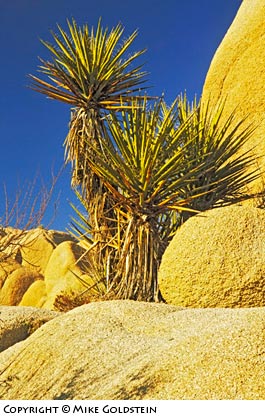
The Mojave yucca (Yucca schidigera ) is prevalent in Joshua Tree National Park, and might be mistaken for a Joshua Tree at times, if one did not look closely. They often grow from cracks in the rocks, and can be photographed with rock formations in the background. Like many other desert plants, it is not a cactus.
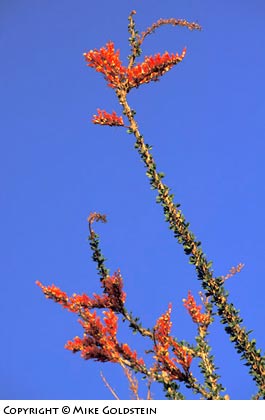
The ocotillo (
Fouqueiria splendens) is a common plant (not a cactus!) found throughout the dry country of the south-west. For most of the year, it appears as a rather tall, skinny, slightly spiny and boring creation.
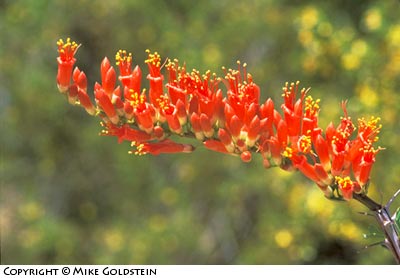
However, like many of its colleagues, in spring this plant produces the most eye-catching flowers, as brilliant as those of the claret-cup cactus, a wonderful red.
To photograph these flowers in macro, be prepared to include a step-ladder in your camera bag, to balance your camera and tripod on top of the cab of your pickup truck, or to pray for a low branch, as I did…
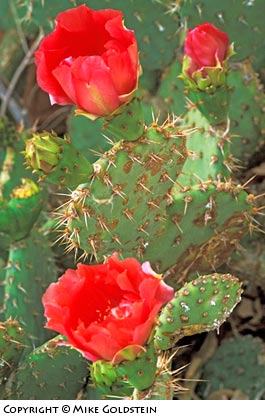
The joy of travelling the south-west in spring, of course, is that this is the season for blossoming cactus. This trip was carefully timed, as Allison had never seen cactus blossoms, and I wanted to increase my collection of cactus blossom photographs. Since the success of the blossom season depends very much on the prior rain history, it’s an iffy thing to come all the way here from Toronto, hoping to find good flowers.
Despite a claim of very dry weather in Joshua Tree this year (2006/2007), we were able to find both yellow and magenta prickly pear (Genus opuntia ) blossoms (not necessarily in Joshua Tree National Park) that were splendid. These particular blossoms were growing between two cottages at 29 Palms Resort, perhaps a quarter mile from the Park boundary!
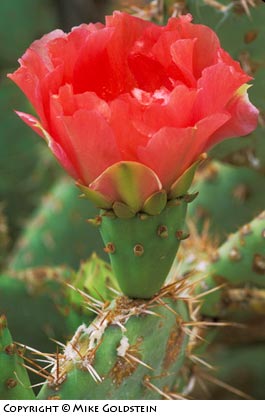
To retain the proper magenta colour of the blossoms, they should be photographed in direct sunlight. However, to control the contrast of the lighting on the background, they should be photographed in the shade. This causes the magenta colour of the blossom to migrate to a pinker shade on daylight slide film.
In this case, the cacti were nicely shaded by the adjacent building, and use of my large diffuser (which I had inadvertently left in Toronto) was not necessary.
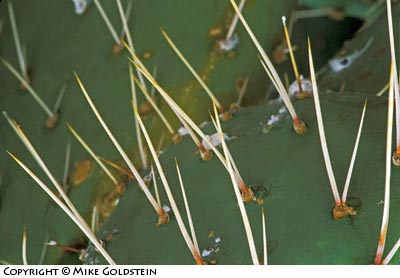
The “prickly pear” cactus (Genus opuntia ) is well-named, considering those impressive two-inch spines that adorn every part of the plant.
This is distinctly unfriendly vegetation!
Like many other natural phenomena, getting really up close and personal can make for some very unusual abstract macro photography. A 180mm macro lens kept me well out of “bleeding” range, and allowed me to fill the frame with the spines.
Hope you enjoyed some of my Joshua tree national park photography helpful toips
by Michael Goldstein

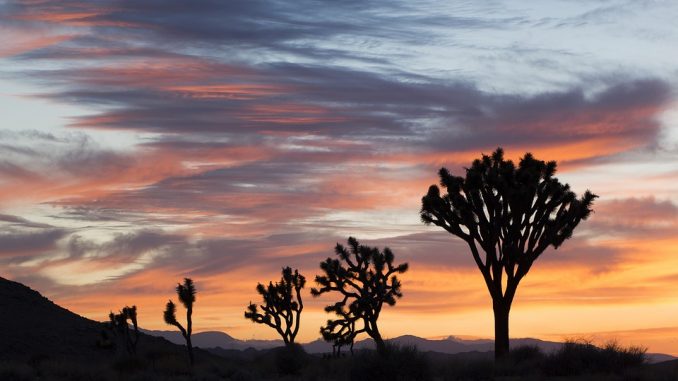
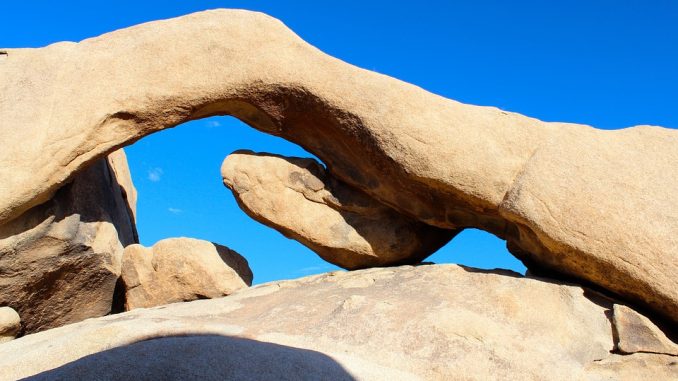
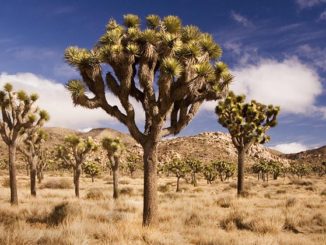
Leave a Reply